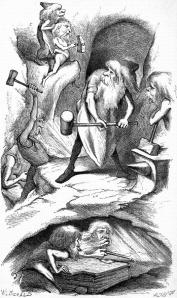Like elves, dwarves have become a staple of modern fantasy literature. Also like elves, this is largely due to the influence of JRR Tolkien, and it’s his version that dominates. These dwarves, despite being short, are brawny and tough, with big beards and big axes. They are champion smiths, miners, and architects, living far beneath the earth in underground cities. That’s the common version, but the history behind it is more complex.
Elves and dwarves both have their roots in Nordic mythology, but where Tolkien mainly based his elves on Celtic lore, his dwarves are very Norse indeed. Tolkien’s dwarves use Nordic runes for writing, often use axes as weapons (very popular amongst the Norse, especially the Danes) and epitomize a certain gruff manliness commonly associated with Vikings. Beyond that, they stick very close to their mythic predecessors in that they are master smiths and craftsmen, sometimes have an unpleasant greedy streak, and live underground. Still, there are significant differences as well, and Tolkien (as well as many other writers) have drawn on dwarf traditions that evolved through the centuries.
The earliest dwarf myths are recorded in Snorri Sturluson’s Prose Edda, and the anonymous Poetic Edda, two books that provide almost all of our knowledge of Nordic myths. Dwarves crop up here and there in the Scandinavian sagas as well. They were called dvergr, and while there were some similarities with dwarves in modern literature, they were still creatures of a whole other sort. Most of their appearances are in stories where they interact with the Norse gods, like Thor and Odin, and we have very little information on what common folk from the period thought of dwarves; the Old Norse weren’t big on writing things down, and the Eddas/sagas were written by later generations.
Dwarves were a popular concept, though. The Norse were famed traders, explorers, and conquerors, and in their travels they spread the idea around, primarily throughout Germany and the British Isles. Here you find creatures like the duergar of Northumberland, whose name seems to derive from dvergr, and the Anglo-Saxon word for an echo translated literally as “dwarf talk,” with the idea being that the dwarves hidden within stones were throwing your voice back at you. Dwarves also persisted into medieval romances, where they changed a great deal, getting mixed in with fairies and other supernatural beings. This would be the period where traditional tales like “Snow White and the Sevens Dwarfs” began to take shape.
There’s also a substantial amount of surviving folklore in Europe about dwarf-like beings, especially in the belief in mine-spirits. Sometimes, like with the duergar, it’s easy to spot the connection, but in other cases it is less so. In Scandinavia dwarves got mixed up with trolls, in Germany and England with fairies, and throughout Europe there are traditions of other diminutive supernatural beings whose origins are not clear, but who could easily be used for literary inspiration either way.
Over the next few weeks I’ll elaborate more on the history of dwarves, pointing out interesting and little known facts. One of the interesting things about mythical beings is that people sometimes seem to think they sprung into the human imagination fully-formed, but most of them underwent this sort of evolution before arriving at the versions we know today. You may find that some interesting ideas got left by the wayside over the years, and hopefully can use them in your own writing.

Great article. Thanks for posting.
You make a great point that people think of mythical beings as appearing one day, fully formed. I hope to contribute to the evolution of dwarfs with my recently-begun writing project.